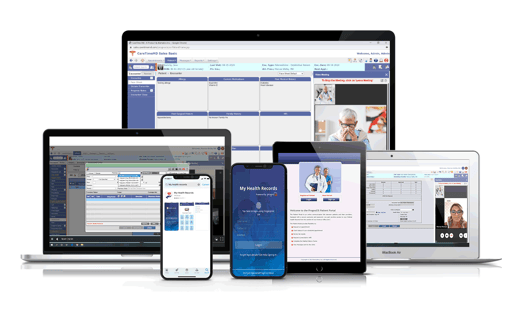What is an EMR System?
An EMR system is a digitized paper chart used within one healthcare practice to manage medical records and streamline workflows. By centralizing patient records, providers can track progress, reduce errors, and deliver more coordinated care. Unlike EHRs, EMRs are typically not shared across organizations and are designed to be used within a single practice.
Explore how different EMR systems can transform your practice.
Key Benefits of EMR Systems
The adoption of EMR systems offers numerous advantages for healthcare providers and patients alike. Key benefits include:
- Enhanced Documentation: Digital records reduce errors from illegible handwriting and ensure consistent, accurate data entry.
- Improved Workflow Efficiency: Automated processes like appointment scheduling and prescription refills save time for staff and providers.
- Better Patient Tracking: EMRs allow providers to monitor health trends, such as changes in vitals or lab results, over time.
- Secure Data Access: Critical information—like prescriptions, allergies, and test results—is readily available while protected by robust security measures.
Unlike paper records, EMR systems are searchable and instantly retrievable, enabling providers to locate patient histories during consultations quickly. This efficiency accelerates diagnosis, optimizes treatment plans, and elevates overall care quality (HealthIT.gov, 2023). Additionally, some types of EMR systems integrate with decision-support tools, providing alerts for drug interactions or reminders for preventive care, further improving outcomes.
![]() Learn more about the benefits of EMR here.
Learn more about the benefits of EMR here.
![]() Learn more about our Specialty EMR Systems.
Learn more about our Specialty EMR Systems.
![]() For insights on how EMR systems contribute to better patient engagement, explore this guide on Patient Engagement.
For insights on how EMR systems contribute to better patient engagement, explore this guide on Patient Engagement.
RevenueXL's EMR system includes customizable workflows, specialty-specific templates, eRx, integrated practice management, patient engagement tools, telehealth capabilities, clearinghouse interfaces, billing integration, and more to enhance efficiency and provider satisfaction.
EMR vs. EHR: Understanding the Difference
Two types of electronic health records systems are used in the healthcare industry. While both systems store patient data, there is a significant difference. Electronic Medical Records are not intended to be shared with other providers involved in the patient's care as they are designed for use within a single healthcare organization. On the other hand, EHRs are designed to be interoperable, meaning they can be shared across multiple healthcare providers involved in a patient's care. This feature of EHRs ensures continuity of care and enhanced patient outcomes.
You can learn more about the differences between EMR and EHR here.
For a detailed comparison between EMR and EHR, visit HealthIT.gov.
Cost of an EMR
The total cost of an EMR typically includes several components, such as software licensing fees, implementation and customization costs, training expenses for staff, ongoing maintenance and support fees, and potential costs associated with data migration and integration with existing systems. Additionally, there may be costs related to hardware infrastructure upgrades or cloud hosting services depending on the deployment model chosen by the healthcare organization.
You can learn more about the cost of implementing an EMR here.
Types of EMR Systems: Cloud-Based, On-Premise, and More
There are essentially many types of EMR Systems, all built to maintain electronic records of patients' health and medical histories. Each type has unique advantages and may suit different practice sizes and specialties.
A. Based on settings for which an EMR is designed
1. Ambulatory
They support outpatient medical facilities, such as primary care clinics, specialty clinics, and physician practices, by meeting their unique needs, including scheduling and appointment management, patient registration, charge capture, and clinical documentation. They may be typically lighter and more streamlined than EHRs designed for inpatient care, focus on ease of use and efficiency for busy outpatient practices, and support the needs of individual practitioners, small clinics, and larger medical groups.
2. Acute Care
Software designed for hospitals and other inpatient care facilities should support the unique needs of inpatient care, including patient admission and discharge, real-time tracking of patient information, and management of complex medical information such as vital signs, lab results, and medications. Such systems may include features such as decision support, alerts and notifications, and integration with clinical decision-support systems.
Generally more comprehensive and complex than software designed for outpatient care, Acute Care software addresses the more complex needs of inpatient care environments and is designed to support the needs of larger healthcare organizations, including hospitals, critical care facilities, and rehabilitation centers.
3. Hybrid
A combination of both ambulatory and acute care EMRs.
B. Based on Specialty
1. Specialty-specific
Specific needs of a particular medical specialty or healthcare organization, such as dermatology, ophthalmology, or mental health clinics, are met by specialty-specific software. They often include pre-configured templates and workflows tailored to the specialty's needs. Still, they may lack the flexibility and customization of general-purpose EMR systems.
-
Advantages: Designed to cater to the unique workflows and requirements of specific medical specialties, such as cardiology, podiatry, or pediatrics. These systems come with pre-configured templates and tools tailored to each specialty.
-
Key Use Case: Practices seeking to enhance efficiency and accuracy by using workflows aligned with their specialty.
2. Multi-specialty
The software needed by healthcare organizations with multiple medical specialties should provide a unified view of patient information across numerous specialties from a single system, regardless of the specialty involved. This can improve efficiency and coordination of care and provide a more complete picture of a patient's health history.
They typically include a range of features and functionalities standard to many different specialties, as well as customization options to meet the specific needs of each specialty. They are generally more flexible and customizable than specialty-specific EMRs and are well-suited to healthcare organizations with multiple specialties, such as large clinics or hospitals.
They can be a good choice for healthcare organizations that need to manage various medical information but still want a unified system for managing patient data.
C. Based on the mode of Deployment
1. Server-based
Also known as on-premise systems, server-based systems are installed and run on a server within a healthcare organization's infrastructure. While the benefit of an on-premise deployment is that you have control over the equipment, that is also a drawback. Medical practices that deploy EMR systems in-house must have an IT expert maintain the hardware, software, and data it stores. If equipment breaks down, it can add unexpected expenses to your bottom line.
-
Advantages: On-premise systems are installed locally on the practice’s servers, offering greater control over data and customization options. However, they require significant IT resources for maintenance.
-
Key Use Case: Best suited for larger practices or organizations with robust IT teams and specific customization needs.
2. Cloud-based
In a cloud-based deployment, patient health information is stored, managed, and accessed online on remote servers instead of local or personal computers. They allow healthcare providers to access patient information from anywhere with an internet connection and enable secure sharing of patient data between different healthcare organizations.
-
Advantages: Accessible from anywhere with an internet connection, cloud-based systems reduce upfront costs and maintenance requirements. These systems are hosted on external servers, making them scalable and cost-effective for small and medium-sized practices.
-
Key Use Case: Ideal for practices with limited IT infrastructure and providers needing remote access to patient data.
3. ASP (Application Service Provider) based
ASP is a type of deployment where the software and data are hosted by a third-party provider, usually on remote servers, and accessed by healthcare organizations over the Internet.
In this model, healthcare organizations pay a fee to access and use the EMR system, and the ASP is responsible for maintenance, upgrades, security, and other technical aspects of the system. This can reduce the cost and complexity of implementing an EMR system for healthcare organizations, as they do not have to invest in and maintain their infrastructure.
D. Based on Open Source vs. Proprietary
EMR systems can also be classified by whether they are open source or proprietary.
1. Open-source
Open-source systems have their source code available for anyone to modify and use. They often have a more active community of developers and can be more customizable, but they may also have limited support options.
-
Advantages: Provide complete control over system features and customization but require technical expertise to implement and maintain. Open-source systems are often a cost-effective option for practices with in-house IT support.
-
Key Use Case: Suitable for tech-savvy practices seeking flexibility and control over system configuration.
2. Proprietary
Proprietary EMR systems are often owned and controlled by a single vendor.
E. Based on Vendor Size
EMR systems can be classified by the type of vendor that provides them. For example, some vendors offer EMR systems for small practices, while others focus on larger healthcare organizations.
5 Common Questions About EMR Systems
What is the difference between EMRs and EHRs?
Read here.
What factors should I consider when choosing an EMR system?
Key factors include the size of your practice, the specific needs of your specialty, your budget, and the system’s integration capabilities. Consulting with an experienced provider like RevenueXL can guide you in selecting the right system.
How do EMR systems improve patient care?
EMR Systems enhance patient care by providing real-time access to comprehensive patient information, timely alerts for critical conditions, and improved communication among care team members.
How secure are EMR systems?
Most modern EMR systems incorporate robust security measures such as data encryption, multi-factor authentication, and role-based access to ensure the confidentiality and integrity of patient data. It is crucial to select a vendor that complies with HIPAA regulations.
Can EMR systems integrate with other healthcare tools?
Yes, many EMR systems are designed to integrate with practice management software, billing systems, e-prescribing tools, and even laboratory systems to create a seamless operational workflow. Interoperability is a key feature to look for when choosing an EMR system.








